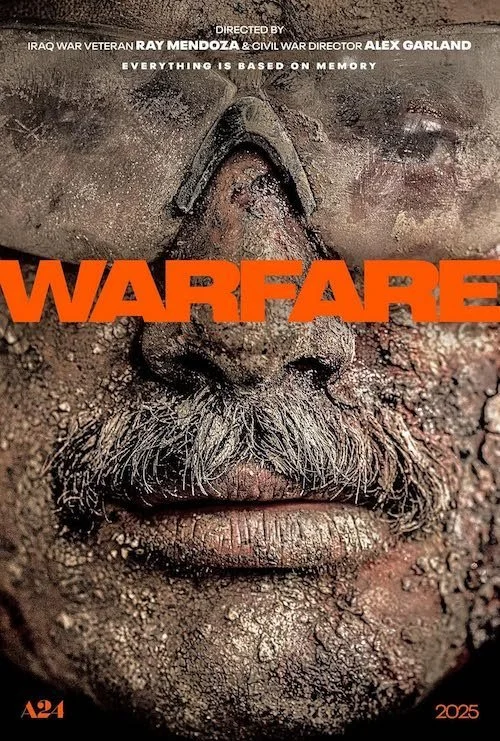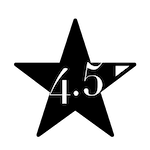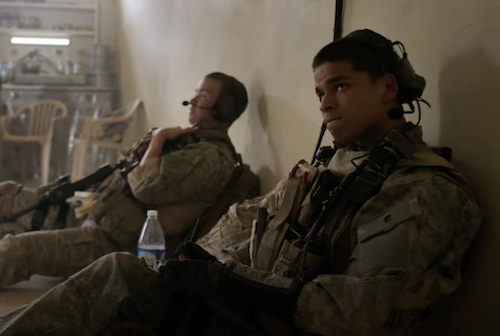Warfare
Written by Andreas Babiolakis
Warning: The following review contains mild to blatant spoilers for Warfare. Reader discretion is strongly advised.
War is hell. No one is denying this. Directors feel the need to address this every so often in film (and I do mean often) for obvious reasons: while it is an honour for millions to serve their countries, the reality of what serving entails must never be forgotten. Many uniformed personnel never make it home. Enough people don’t even survive their first mission. War films usually try to fit in as much truth as possible to varying results: three-hour epics with many battles that all wind up possessing the same message. The best war films (or anti-war films, depending on the title and your opinion) know how to say as much as possible with every waking moment, no matter how similar each battle sequence is from the last. Last year, auteur Alex Garland flirted with the idea of a war film with the appropriately titled Civil War, which — to me — reads more like a political thriller than a straight up war project. If anything, his science-fiction masterpiece, Annihilation, may convey stronger anti-war themes: the thought of a squad of uniformed women heading deeper and deeper into the “shimmer” will be rendered forever changed (the shimmer clearly represents multiple ideas, like cancer growths and mental health concerns, but I feel like there is a strong depiction of vets being driven mad by their assignments).
Now, to call Warfare a Garland film through and through is only somewhat correct. The director’s sense of chilling pacing, his ability to get the most out of his actors, and the breathtaking effects are all present. However, Warfare is a shared project; Garland works alongside an Iraq war vet, Ray Mendoza, and the two directed and wrote Warfare together. Mendoza served in the Alpha One Navy SEAL team present in the film and is played by actor D’Pharoah Woon-A-Tai (of Reservation Dogs fame). The mission present in Warfare actually happened, and Mendoza lends his experiences and memories to the writing and direction of this film as accurately as possible. You can sense the authenticity leaping off of the screen in Warfare down to some of the quirks that a creative writer would usually not even consider to toss in (like an awkward dance before a mission to express excitement, or a wounded comrade accidentally being stepped on).
Warfare plays its cards very carefully and only at the right moments.
Then there is the decision to make a vast majority of the film (save for a couple of opening scenes) presented in real time: the concept that a film never leaps ahead in time but, rather, plays out as if what we are seeing is actively happening (for instance, if Warfare needs to step away from what is happening with our main characters, we will cut to what someone else is experiencing at that very moment instead of fast forwarding to the next step in our protagonists’ journey). The slow-burn choice to present Warfare in real time gives us no choice but to take in each and every moment of this nightmare. There’s no saving grace in Warface; no checkpoints; no comedic relief; no cutaways from the worst visions of war. We feel the desperation of those who sought to serve their country and are now facing their worst fates. Warfare feels alarmingly real, and that rings true in the music selection as well. There’s no score that accompanies what we see. Only two songs by professional musicians that bookend Warfare. The film opens to the once highly-popular track “Call on Me” by Eric Prydz (the one with the hyper-sexualized work-out video music video); that very video is being watched by Alpha One while they are preparing for their first mission. They hoot, holler, cheer, and hype themselves as much as possible. The title of the song is no coincidence: these are men who want to be reliable fighters for their country. The end of the film — with a montage of the real fighters and their acting counterparts — is paired with slowcore band Low’s magnificent song “Dancing and Blood” off of Double Negative. The song is about ultimate sacrifice during war or political turmoil and the realization that all of it “wasn’t enough”; the throbbing, haunting beat escorts us out of a film full of panic and death, while it provides an eeriness to the smiling portraits of the film’s actors and the snapshots of a real battleground and its navigators.
Warfare plants us in a complex seized by Alpha One while they are keeping tabs on neighbouring markets and houses via a rifle’s scope. Warfare starts off glacially, as we continue waiting for something to happen; not only are we experiencing the life of an actual fighter and what their anxious waiting entails, but we are quickly seeking forgiveness when that sought-after action happens and we see what damage it causes. Warfare makes itself known that it isn’t a vessel for entertainment but, rather, a purveyor of information as to what war would be like for the uninitiated. You’ll quickly find that Warfare takes its time with each and every step, but that is the reality of the situation: no action in war is over and done with quickly. By the end of the film, I was astounded as to how much we got from so little actual plot development: proof that Garland and Mendoza knew how to make the most of very little. This risk sets Warfare apart from other war-based films, even an experiment like Sam Mendes’ one-shot marvel, 1917 (which traverses much land and manages to portray many aspects of war, whereas Warfare focuses on literally one key mission gone wrong and its repercussions).
Warfare is a welcome entry in the anti-war film genre because of how upfront and unfiltered it is.
The entire film is jaw-dropping, from the seldom use of special effects (but, my, how special they are, from the impact of flying jets and the dust that is picked up by them, to the rare-but-mighty roars and quakes caused by explosives) to a superstar cast of some of this generation’s finest male leads (the aforementioned Woon-A-Tai, who is sublime here, is joined by the likes of Will Poulter, Charles Melton, Joseph Quinn, Cosmo Jarvis, and numerous other strong actors). While the film never lets up for its hour-and-a-half, its biggest gamble is how it ends: rather quietly. This stark vision not only reminds us that war is forever ongoing and the concept of humans killing humans will sadly never end, but the unshakable image of cleared streets being slowly populated once the coast is clear is one that will change the entire message of Warfare literally as soon as you are about to finish watching it. For a film that is being unjustly pegged as “pro-war” and hyper American by many who refuse to see the film (therein lies the problem), Garland and Mendoza save their biggest card for last. For all of the reasons above (toss in great sound design and stellar cinematography to boot), it goes without saying that Warfare should be experienced on the biggest screen possible. Please go see it in a cinema.
I adore Kathryn Bigelow’s similar epic Zero Dark Thirty, and a major triumph in her 2012 film is the concluding sequence featuring a real-time hunt for Osama bin Laden that lasts around half an hour, if memory serves correctly. Garland and Mendoza achieve a similar conquest for an hour and a half. The end result is a nail-biting film that, sure, displays clear anti-war sentiments but also honours those who will continue to choose to serve their countries. It feels like a bizarre middle ground where the concept of what is right and wrong is shattered. This is just a dust-filled, blood-stained limbo, and all parties need to get out now. If Garland is standing by his word and directing fewer films after Warfare, then this is a bittersweet day. Warfare is an excellent release that shook me to my core and feels like a hint of how much creativity and passion is still left in the auteur’s tank. It feels like an early highlight in 2025’s cinema, and another slam dunk by a fantastic contemporary filmmaker (with the aide of a veteran who I hope found catharsis in Warfare, because his truth is a major reason why this film is as effective and impactful as it stands).
Andreas Babiolakis has a Masters degree in Film and Photography Preservation and Collections Management from Toronto Metropolitan University, as well as a Bachelors degree in Cinema Studies from York University. His favourite times of year are the Criterion Collection flash sales and the annual Toronto International Film Festival.








